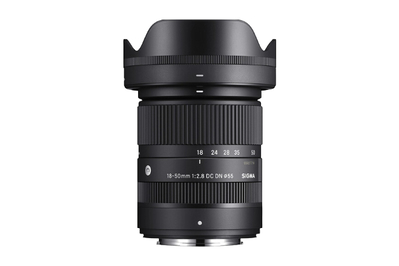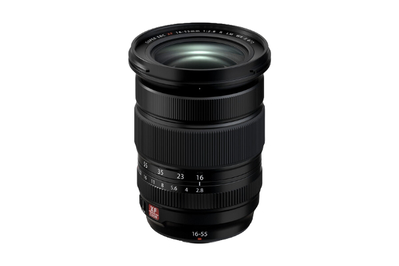
Fujifilm’s kit lenses are a cut above the cheap commodity glass of generations past, but like most kit lenses, they’re restricted by variable apertures that get dimmer the further you zoom in. This can make them difficult to use in dimmer environments, limiting their utility.
If you’re yearning for better image quality from a versatile short zoom, Fujifilm and a range of third-party lens makers offer lenses that cover a similar field of view but with fast, constant maximum apertures and improved sharpness and distortion. Following are two recommendations: one cost-effective and small, with some shortcomings, and one nearly free of flaws but more expensive.
Top pick
If you want a lens that covers ground similar to what your camera’s kit zoom is capable of, but want improved image quality and better low-light capability, the Sigma 18–50mm f/2.8 DC DN Contemporary is a great choice. It’s small, lightweight, and a great performer. Just be aware that it lacks optical stabilization.
It’s a strong optical performer. This lens is sharp from the get-go, regardless of the focal length you choose, and it only gets crisper as you stop down. It produces lovely background blur at f/2.8, and in a pinch it can even function as a solid portrait lens at its longer focal lengths.
It is not as sharp in the extreme corners as the Fujifilm XF 16–55mm f/2.8 II, which we recommend below, but most people will find it a nice step up from a kit lens. Its colors are also pleasing, if a touch cooler than those you’d get from the 16–55mm lens.
It’s versatile. With its constant f/2.8 maximum aperture, it can gather more light than Fujifilm’s kit lenses. That means you can use it in a wider range of scenarios, including indoors and in other low-light situations where a variable-aperture lens would struggle.
It can also focus down to 4.8 inches from your camera’s sensor, which gives it near-macro magnification capability. However, in our tests, images that we shot extremely close up showed substantial aberrations (specifically color fringing) and reduced contrast near the minimum focus distance. Thankfully, those aberrations dropped away when we moved a couple of inches farther from the sensor.
It actually weighs less than Fujifilm’s typical kit lens. Usually, a wide, constant maximum aperture means a lens will be big and heavy. The Sigma 18–50mm f/2.8 DC DN Contemporary bucks that trend. Compared with the Fujifilm XF 18–55mm f/2.8-4 R LM OIS kit lens, which weighs 10.9 ounces (308 grams) and measures about 2.8 inches long, this Sigma lens weighs 10.1 ounces (286 grams) and is just a hair longer at 2.9 inches.
It’s protected against the elements but lacks optical image stabilization. Like Fujifilm’s better kit lenses, this Sigma model is also equipped with weather sealing against dust and moisture. However, it lacks optical image stabilization, so it’s best used with a camera that has in-body image stabilization (IBIS)—a group that includes most recent Fujifilm bodies.
If you use an X-M5, an X-Pro3, or an older camera such as the X-T30 or X-T2, you should consider paying more for a lens like the Tamron 17–70mm F/2.8 Di III-A VC RXD. It costs more and is bigger and heavier than the Sigma 18–50mm f/2.8 DC DN Contemporary, and it isn’t as optically perfect as the Fujifilm XF 16–55mm f/2.8 R LM WR II (discussed below), but it provides about as much sharpness as the Sigma model, offers more range, and features Tamron’s Vibration Control (VC) optical stabilization.

Upgrade pick
Despite being relatively small and lightweight, the Fujifilm XF 16–55mm f/2.8 R LM WR II outperformed other fast, constant-aperture normal zooms in our testing in every respect—it’s sharper, has better contrast, shows fewer aberrations, and renders truer colors. It also costs $1,200, in contrast to the Sigma 18–50mm f/2.8 DC DN Contemporary’s usual price of $500, but that’s the price you pay for optical supremacy.
It’s really sharp. No zoom is as sharp as a great prime lens, but unlike the other fast, constant-aperture zooms we tested in this category, the XF 16–55mm f/2.8 R LM WR II is pleasingly sharp (if not perfectly so) all the way into the extreme corners of the image at most focal lengths. That’s true even at f/2.8. It could be sharper toward the edge of the frame at 16mm, but in our tests it still bested what we saw from the Sigma and Tamron f/2.8 zooms we tried.
It renders pleasing, natural colors with plenty of contrast. Whereas the Sigma lens’s images needed some touchup in Lightroom to look their best, this Fujifilm lens delivered more lifelike color and better contrast, making its straight-out-of-the-camera JPEGs more usable without tweaking.
It’s virtually free of color fringing, haze, and other optical imperfections. When we shot with the Sigma lens near its minimum focus distance, it exhibited lots of cyan fringing around high-contrast subjects, as well as an overall reduction in contrast and some loss of sharpness.
This Fujifilm lens, however, retained all of its punchiness close up and showed zero fringing or other flaws in our tests. It also produced much better-defined sunstars and had fewer issues with flare than the Sigma lens did.
Note that its minimum focus distance is more than twice as long as that of the Sigma lens, at 11.8 inches from the sensor. However, in our tests it showed far fewer aberrations at that distance than the Sigma lens did at its maximum magnification.
It’s lightweight and compact for a constant-aperture zoom. Although it’s a little heavier and longer than the Sigma lens, this Fujifilm optic is still just 14.4 ounces (408 grams) and 3.7 inches long—plenty small enough to accompany you on an average day of shooting or even a longer vacation.
You can de-click its aperture ring for video recording. The XF 16–55mm f/2.8 R LM WR II is one of the first Fujifilm lenses we’ve seen to offer a switch for you to de-click the aperture ring. This is important for videography, because it allows for seamless changes of aperture while you’re recording. It also prevents the audible clicks from aperture changes from being picked up on the audio track of a video clip.
An extra $700 still doesn’t buy you optical image stabilization. Like the Sigma lens, this lens is fully weather-sealed but lacks built-in image stabilization, instead relying on in-body stabilization.






